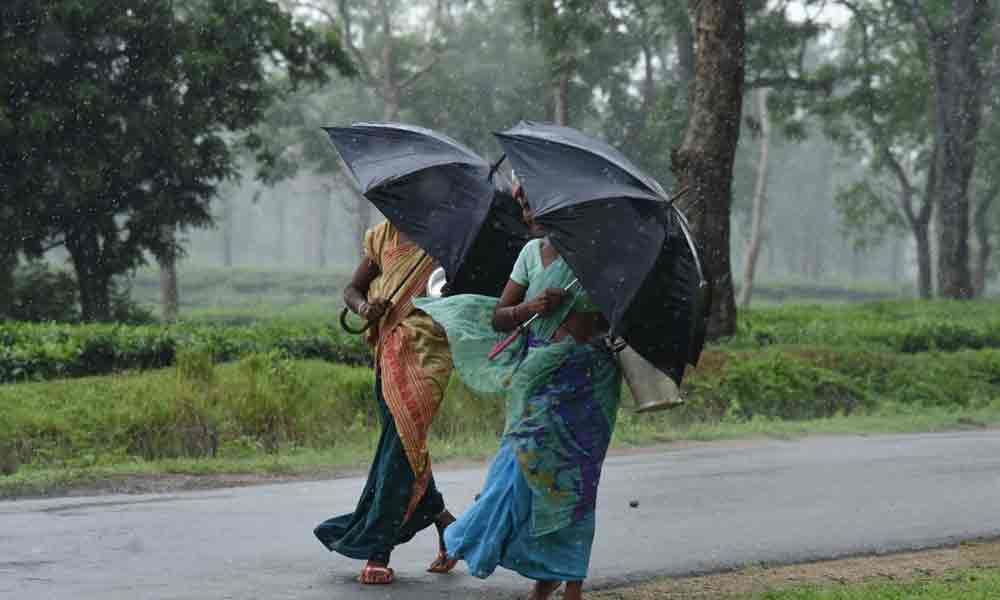Live
- Narsipatnam tank bund my dream project, says Speaker
- MLA Yashaswini slams Errabelli
- Sluggish pace persists at Stamps & Registration Office
- Kanguva’s Box Office Disaster: Is This the End of Suriya’s Mega Hit?
- Maoist killed, jawan injured in encounter
- Kerala Police Officer Brutally Murdered By Estranged Husband In Tragic Domestic Violence Case
- Pallishree Mela records good sales at Bali Jatra
- Kharif paddy purchase begins in Bargarh
- Faeces forced into tribal woman’s mouth
- Hyderabad's Air Quality Worsens as Winter Settles In | AQI Levels Reach Moderate Range
Just In
Weak monsoon raises fears over crops, economy


Monsoon rains were below average for the fourth straight week, with rainfall scanty over central and western parts of the country in the week, raising concerns about major crop production and the impact on the economy.
Mumbai: Monsoon rains were below average for the fourth straight week, with rainfall scanty over central and western parts of the country in the week, raising concerns about major crop production and the impact on the economy.
Monsoon rains are crucial for the country's farm output and economic growth. About 55 per cent of the country's arable land is rain-fed, and agriculture makes up about 15 per cent of a $2.5 trillion economy, which grew at its slowest in more than four years over the January-March quarter. The economy may take a big hit from the poor monsoon this year.
If the rains don't improve over the next two to three weeks, the country could be facing a crisis that hammers crop harvests and rural demand. Companies that sell everything from tractors to fertiliser to consumer goods to farmers would be vulnerable.
"Sowing has already been delayed by three weeks. If the monsoon doesn't revive in two, three weeks, then the entire season could be wiped out," said Harish Galipelli, head of commodities and currencies at Inditrade Derivatives & Commodities in Mumbai.
India received 24% less rainfall than the 50-year average in the week ended on June 26, data from the India Meteorological Department (IMD) shows. In some areas, such as the eastern part of Madhya Pradesh, known for growing soybean, the deficit was as high as 69 per cent, the data shows.
The monsoon has so far delivered 36 per cent less rainfall than normal since the start of the season on June 1 due to a delay in the onset of the seasonal rains. The sowing of summer crops such as rice, soybeans and corn has been lagging as a result. Farmers had planted summer-sown crops on 9.1 million hectares as of June 21, down 12.5 per cent compared with the same time last year, according to provisional data from ministry of agriculture.
The country needs a good monsoon this year as in 2018 a drought ravaged crops, killed livestock, emptied reservoirs and drained water supplies to city dwellers and some industries. Hardest hit were the western states of Maharashtra and Gujarat, along with Tamil Nadu, Karnataka, Andhra Pradesh and Telangana in the south, and Madhya Pradesh in central India.
Some municipalities like Chennai, Mumbai and Hyderabad were forced to cut water supplies to ensure their reserves lasted until monsoon rains replenished reservoirs. The IMD has forecast average rainfall in 2019, while the country's only private forecaster, Skymet, has predicted below-normal rainfall.
A normal, or average, monsoon means rainfall between 96 per cent and 104 per cent of a 50-year average of 89 cm (35 inches) during the four-month monsoon season from June to September, according to the IMD's classification.
Meanwhile, the Kotak Report said that till June 26 the cumulative rainfall was 36.8 per cent below normal with the weekly rainfall 23.9 per cent below standard. "This is the weakest start to the monsoon since 2014 when cumulative rainfall was 38.2 per cent below normal for the same period," the report said.
The other major point raised was that the basin-wise reservoir levels slipped into deficit compared to long-term average levels. Of the larger river basins only Godavari and Indus were in surplus while Ganga, Kaveri, Krishna, Mahanadi were in deficit, the report said. Adding that overall basins and reservoirs were around 14.5 per cent below long-term average for the week ending June 27.

© 2024 Hyderabad Media House Limited/The Hans India. All rights reserved. Powered by hocalwire.com






